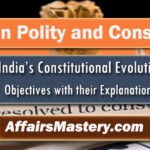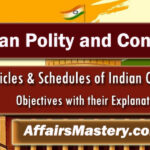Set 1 | Unlock Your Knowledge: MCQs on Making of Constitution
Unlock Your Knowledge: MCQs on Making of Constitution. Constituent Assembly and making of the Constitution plays a huge role in shaping Indian Polity and Governance, and it’s one of those things that really lays the groundwork for doing well in competitive exams—whether it’s Civil Services, State exams, SSC, Railways, Banking, or any of the others out there.
Diving deep into Indian Polity, Constitution, and governance isn’t just about memorizing facts or ticking boxes for exams, but more about developing the kind of awareness that can make navigating these challenging exams a little less overwhelming and a lot more manageable.
| MCQs on Making of Constitution – Objective Questions and Answers |

Q1. The idea of the Preamble has been borrowed in Indian Constitution from the Constitution of – (U.P.P.C.S. (Pre) 2015)
[A] Italy
[B] Canada
[C] France
[D] U.S.A.
View Explanation
Correct Answer is D.
India got the idea of the Preamble from the U.S. Constitution, the other options also had some influence but in different ways.
- Italy – Inspired India’s principles of social justice and welfare state.
- Canada – Contributed to the federal structure with a strong central government.
- France – Gave the ideas of Liberty, Equality, and Fraternity, which are mentioned in the Preamble itself.
Q2. The concept of “A Union of States in the Indian Constitution” has been derived from: (U.P.P.C.S. (Pre) 2017)
[A] The American Declaration of Independence
[B] The Australian Constitution
[C] The British North-American Act
[D] The Swiss Constitution
View Explanation
Correct Answer is C.
- The idea of calling India “A Union of States” in the Constitution actually comes from the British North America Act of 1867. If we look at Article 1(1) of the Indian Constitution, it clearly says that “India, that is Bharat, shall be a Union of States.”
- Now, when the Constituent Assembly was discussing this, the Drafting Committee felt that, even though India’s system might look federal in the way it functions, it wouldn’t really be right to just call it a federation.
- That’s why they decided to use the phrase “Union of States”, following the way it was worded in the British North America Act.
Q3. In Indian political system which one is supreme? (U.P.P.C.S. (Mains) 2013)
[A] The Supreme Court
[B] The Constitution
[C] The Parliament
[D] Religion
View Explanation
Correct Answer is B.
In the Indian political system, the supreme authority is the Constitution.
- [A] The Supreme Court – It is the highest judicial authority but works within the limits set by the Constitution.
- [B] The Constitution – The ultimate authority that defines the structure, powers, and functioning of all institutions, including the government, judiciary, and legislature. (Correct Answer)
- [C] The Parliament – It makes laws, but even Parliament cannot go against the Constitution.
- [D] Religion – India is a secular country, meaning religion does not hold political supremacy.
Q4. The concept of ‘Judicial Review’ in India has been adopted from the Constitution of – (U.P.P.C.S. (Pre) 1998)
[A] U.K
[B] U.S.A.
[C] U.S.S.R.
[D] Australia
View Explanation
Correct Answer is B.
The concept of Judicial Review in India has been adopted from the Constitution of the U.S.A.
- [A] U.K. – Follows the principle of Parliamentary Sovereignty, meaning courts cannot overrule laws made by Parliament.
- [B] U.S.A. – The idea of Judicial Review (power of courts to declare laws unconstitutional) comes from the U.S. Supreme Court’s decision in Marbury v. Madison (1803). (Correct Answer)
- [C] U.S.S.R. – Had a socialist system with no Judicial Review, as laws were dictated by the Communist Party.
- [D] Australia – Follows a federal system but did not contribute directly to India’s Judicial Review concept.
Q5. Given below are two statements: (U.P.P.C.S. (Pre) 2017)
Assertion (A) : The scope of Judicial review is limited in India.
Reason (R) : Indian constitution has some borrowed items.
Select the right answer from the code given below: Code :
[A] Both (A) and (R) are correct and (R) is the right explanation of (A).
[B] Both (A) and (R) are correct but (R) is not the right explanation of (A).
[C] (A) is correct, but (R) is wrong.
[D] (A) is wrong, but (R) is correct.
View Explanation
Correct Answer is B.
- The Judicial Review power in India isn’t absolute, it has its limits. In the Kesavananda Bharati case (1973), the Supreme Court came up with the Basic Structure Doctrine, which basically means that even though Parliament can change the Constitution, it cannot mess with its core principles.
- This is why Assertion (A) is correct—the judiciary can review and even strike down amendments, but only if they harm the Constitution’s basic structure.
- Now, on the other side, it’s also true that the Indian Constitution has taken a bunch of ideas from different countries, which makes Reason (R) correct too.
- But if we think about it, just saying that India borrowed things from other places doesn’t really explain why the judiciary has the power to review amendments. That’s why, even though both statements are right, Reason (R) doesn’t properly explain Assertion (A).
Q6. The feature of Federal system of the Indian Constitution is inspired by the constitution of: (U.P.P.C.S. (Mains) 2006)
[A] Canada
[B] United Kingdom
[C] U.S.A.
[D] Ireland
View Explanation
Correct Answer is A.
The Federal system in the Indian Constitution is primarily inspired by the Constitution of Canada.
- [A] Canada – India adopted a federal system with a strong central government, similar to Canada’s model. (Correct Answer)
- [B] United Kingdom – The U.K. follows a unitary system.
- [C] U.S.A. – While the U.S. has a federal structure, India’s federalism is closer to Canada’s, with a strong center rather than a completely autonomous division of powers.
- [D] Ireland – Ireland influenced Directive Principles of State Policy (DPSP).
Q7. The Indian Parliamentary System is different from the British Parliamentary System in that India has: (I.A.S. (Pre) 1998)
[A] Both a real and a nominal executive
[B] A system of collective responsibility
[C] Bicameral legislature
[D] The system of judicial review
View Explanation
Correct Answer is D.
- [A] Both a real and a nominal executive – This is common in both India and the U.K. In both countries, the President (India) and the King/Queen (U.K.) are nominal executives, while the Prime Minister is the real executive.
- [B] A system of collective responsibility – This also exists in both India and the U.K., where the Council of Ministers is collectively responsible to the legislature.
- [C] Bicameral legislature – Both India and the U.K. have two houses in Parliament (Lok Sabha & Rajya Sabha in India, House of Commons & House of Lords in the U.K.).
- [D] The system of judicial review – This is where India differs from the U.K. In India, courts have the power of judicial review, meaning they can strike down laws if they violate the Constitution. In the U.K., Parliament is supreme, and courts cannot overrule laws made by Parliament. (Correct Answer)
Q8. The system of judicial review exists in (U.P. P.C.S. (Mains) 2012)
[A] India only
[B] U.S.A only
[C] India and U.S.A.
[D] U.K. only
View Explanation
Correct Answer is C.
- Both countries have the system of Judicial Review, where courts can declare laws unconstitutional if they violate the fundamental principles of the Constitution.
Q9. Which of the following characteristics is common between the Federal system of India and America? (I.A.S. (Pre) 1993)
[A] A Single Citizenship
[B] Three lists in the Constitution
[C] Dual Judicial System
[D] A Federal Supreme Court for Interpretation of the Constitution
View Explanation
Correct Answer is D.
- [A] A Single Citizenship – India follows single citizenship (like the U.K.), while the U.S. has dual citizenship (citizenship of both the country and the state).
- [B] Three lists in the Constitution – India has three lists (Union, State, and Concurrent), while the U.S. follows a two-list system (Federal and State powers).
- [C] Dual Judicial System – The U.S. has a dual judicial system (separate federal and state courts), while India has a unified judiciary under a single system.
- [D] A Federal Supreme Court for Interpretation of the Constitution – Correct answer. Both India and the U.S. have a Supreme Court with the power to interpret the Constitution and decide disputes between the central and state governments.
Q10. Which of the following statements is true? (38th B.P.S.C. (Pre) 1992)
[A] The Federal form of Government is in United States of America.
[B] The government of India is federal and unitary both.
[C] The government of France is of federal form.
[D] The Prime Minister of Pakistan is appointed by the people.
View Explanation
Correct Answer is A.
- The United States of America runs on a federal system, meaning power is divided between the national government and the 50 states, and each has its own authority in its respective domain.
- Now, when we talk about India, it is described as a Union of States under Article 1 of the Constitution, which means that while there are 28 states and 8 Union Territories, they cannot break away from the country—it’s one whole system.
- A federal government is one where power is shared between the central and state governments, with both having their own responsibilities defined by the Constitution.
- Each level of government works independently within its own area. Some constitutional experts have often said that India’s system has a unitary character, mainly because during times of emergency, the central government becomes much stronger.
- However, when we look at it properly, India’s system is fundamentally federal, though it does have a few unitary elements built into it.



